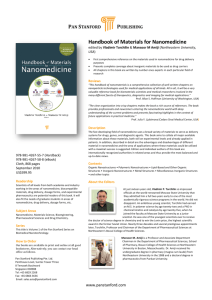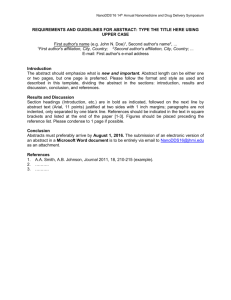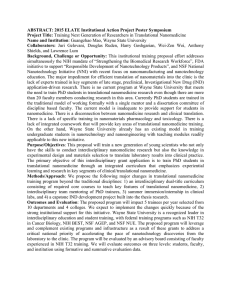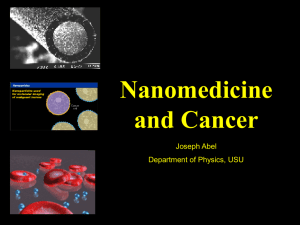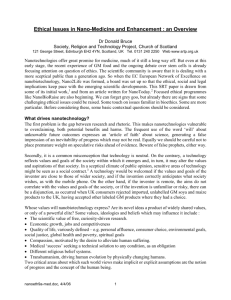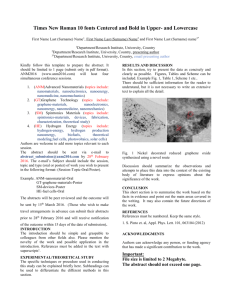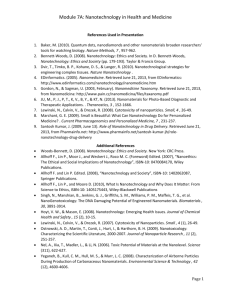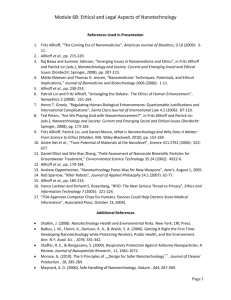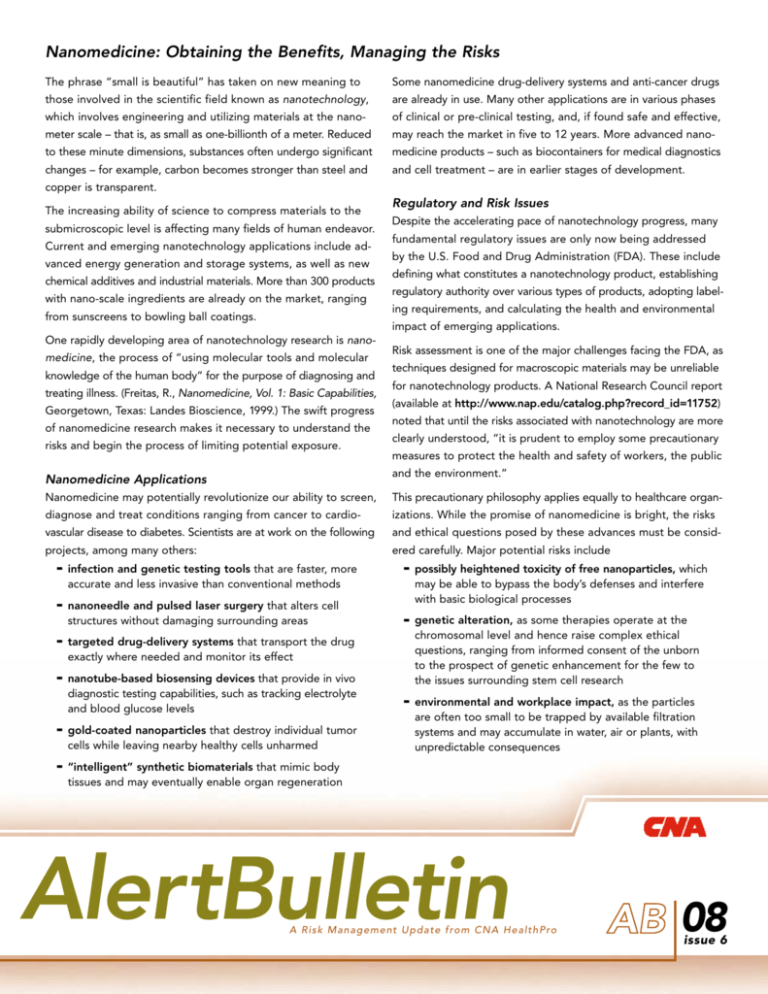
Nanomedicine: Obtaining the Benefits, Managing the Risks
The phrase “small is beautiful” has taken on new meaning to
Some nanomedicine drug-delivery systems and anti-cancer drugs
those involved in the scientific field known as nanotechnology,
are already in use. Many other applications are in various phases
which involves engineering and utilizing materials at the nano-
of clinical or pre-clinical testing, and, if found safe and effective,
meter scale – that is, as small as one-billionth of a meter. Reduced
may reach the market in five to 12 years. More advanced nano-
to these minute dimensions, substances often undergo significant
medicine products – such as biocontainers for medical diagnostics
changes – for example, carbon becomes stronger than steel and
and cell treatment – are in earlier stages of development.
copper is transparent.
The increasing ability of science to compress materials to the
submicroscopic level is affecting many fields of human endeavor.
Current and emerging nanotechnology applications include advanced energy generation and storage systems, as well as new
chemical additives and industrial materials. More than 300 products
with nano-scale ingredients are already on the market, ranging
from sunscreens to bowling ball coatings.
Regulatory and Risk Issues
Despite the accelerating pace of nanotechnology progress, many
fundamental regulatory issues are only now being addressed
by the U.S. Food and Drug Administration (FDA). These include
defining what constitutes a nanotechnology product, establishing
regulatory authority over various types of products, adopting labeling requirements, and calculating the health and environmental
impact of emerging applications.
One rapidly developing area of nanotechnology research is nanomedicine, the process of “using molecular tools and molecular
knowledge of the human body” for the purpose of diagnosing and
treating illness. (Freitas, R., Nanomedicine, Vol. 1: Basic Capabilities,
Georgetown, Texas: Landes Bioscience, 1999.) The swift progress
of nanomedicine research makes it necessary to understand the
risks and begin the process of limiting potential exposure.
Risk assessment is one of the major challenges facing the FDA, as
techniques designed for macroscopic materials may be unreliable
for nanotechnology products. A National Research Council report
(available at http://www.nap.edu/catalog.php?record_id=11752)
noted that until the risks associated with nanotechnology are more
clearly understood, “it is prudent to employ some precautionary
measures to protect the health and safety of workers, the public
Nanomedicine Applications
and the environment.”
Nanomedicine may potentially revolutionize our ability to screen,
This precautionary philosophy applies equally to healthcare organ-
diagnose and treat conditions ranging from cancer to cardio-
izations. While the promise of nanomedicine is bright, the risks
vascular disease to diabetes. Scientists are at work on the following
and ethical questions posed by these advances must be consid-
projects, among many others:
ered carefully. Major potential risks include
-infection and genetic testing tools that are faster, more
accurate and less invasive than conventional methods
-nanoneedle and pulsed laser surgery that alters cell
structures without damaging surrounding areas
-targeted drug-delivery systems that transport the drug
exactly where needed and monitor its effect
-nanotube-based biosensing devices that provide in vivo
diagnostic testing capabilities, such as tracking electrolyte
and blood glucose levels
-gold-coated nanoparticles that destroy individual tumor
cells while leaving nearby healthy cells unharmed
-“intelligent” synthetic biomaterials that mimic body
-possibly heightened toxicity of free nanoparticles, which
may be able to bypass the body’s defenses and interfere
with basic biological processes
-genetic alteration, as some therapies operate at the
chromosomal level and hence raise complex ethical
questions, ranging from informed consent of the unborn
to the prospect of genetic enhancement for the few to
the issues surrounding stem cell research
-environmental and workplace impact, as the particles
are often too small to be trapped by available filtration
systems and may accumulate in water, air or plants, with
unpredictable consequences
tissues and may eventually enable organ regeneration
AlertBulletin
A R i s k M a n a g e m e n t U p d a t e f ro m C N A H e a l t h P ro
08
issue 6
-healthcare paradigm shift, as new technologies possibly
result in obsolescence for some established therapeutic
modalities, creating new financial and administrative
demands in terms of equipment, care settings, and staff
training and competencies.
Strategies
As the nanomedicine revolution unfolds, healthcare organizations
must find effective ways to ensure patient safety and reduce the
liability risks inherent in adopting cutting-edge diagnostic and
treatment techniques. The following proactive measures can assist
your healthcare organization in maximizing the potential benefits
of nanomedicine while minimizing associated risks:
-Create a nanomedicine task force composed of clinical
and administrative leaders with a high level of scientific
sophistication to research nanomedicine prospects, benefits, costs and risks, and incorporate the group’s findings
into the strategic planning process.
-Undertake prospective risk analysis to address areas of
potential enterprise liability, including adverse outcomes,
environmental hazards, and implicit warranties or guarantees contained within marketing materials.
-Initiate a discussion with the ethics committee regard-
ing emerging nanomedicine issues, including use of stem
cells and the question of genetic enhancement.
-Develop a risk posture vis-à-vis nanomedicine, in collabo-
ration with legal counsel, and ensure that risk and insurance
coverage issues are factored into decisions involving nanomedicine. Recognize that insurers may not be able to make
a blanket generalization concerning coverage for nanomedicine risks, which at this point are difficult to predict and/or
quantify. As with all legal causes of action, nanomedicinerelated claims would be assessed on an individual basis.
-Adapt your organization’s informed consent policies to
the new realities, taking into account the generally low
state of consumer awareness regarding nanomedicine and
the unknowns that accompany a radically new technology.
Specifically, your informed consent process for nanomedicine therapies should encompass an extensive educational
component for patients and acknowledge the limitations
of current knowledge and experience in this area.
-Strengthen policies and systems designed to track
patients within the institution, report adverse events,
and monitor equipment and suppliers. Designate those
responsible for reporting incidents to the FDA and/or
the manufacturer and ensure that personnel understand
internal reporting rules and procedures.
-Revise competency and credentialing models for pro-
viders and staff to include emerging technologies and
approaches. Ensure that staff members are familiar with
policies regarding nanotechnology applications and
acceptable off-label uses.
-Manage the product supply chain and establish policies
regarding the presence of vendor representatives in clinical
settings where treatment is rendered.
-Advocate for more basic scientific and safety research
on nanomedicine and nanotoxicology, as sound regulation and more manageable risk will require a deeper level
of theoretical and empirical knowledge.
Resources
Ebbesen, M., Jensen, T. “Nanomedicine: Techniques, Potentials
and Ethical Implications.” Journal of Biomedicine and Biotechnology, 2006, Article ID 51516, pp. 1-11. Available at http://www.
hindawi.com/getarticle.aspx?doi=10.1155/jbb/2006/51516.
Freitas, R. “Current Status of Nanomedicine and Medical
Nanorobotics.” Journal of Computational and Theoretical
Nanoscience, 2005, Volume 2:1, pp. 1-25. Available at http://
www.nanomedicine.com/Papers/NMRevMar05.pdf.
Nanotechnology: A Report of the U.S. Food and Drug Administration Nanotechnology Task Force, July 25, 2007. Department
of Health & Human Services. Available at http://www.fda.gov/
nanotechnology/taskforce/report2007.pdf.
“Nanotechnology: Untold Promise, Unknown Risk.”
ConsumerReports.org, July 2007. Available at http://www.
consumerreports.org/cro/health-fitness/nanotechnology7-07/overview/0707_nano_ov_1.htm.
Walker, B., Mouton, C. “Nanotechnology and Nanomedicine: A
Primer.” Journal of the National Medical Association, December
2006, Volume 98:12, pp. 1985-1988.
1.888.600.4776
www.cna.com/healthpro/
CNA HealthPro, 333 S. Wabash Avenue, Chicago, Illinois 60604
Published by CNA. For additional information, please call CNA HealthPro at 1-888-600-4776. The information, examples and suggestions presented in this material
have been developed from sources believed to be reliable, but they should not be construed as legal or other professional advice. CNA accepts no responsibility for
the accuracy or completeness of this material and recommends the consultation with competent legal counsel and/or other professional advisors before applying this
material in any particular factual situations. This material is for illustrative purposes and is not intended to constitute a contract. Please remember that only the relevant
insurance policy can provide the actual terms, coverages, amounts, conditions and exclusions for an insured. All products and services may not be available in all states.
CNA is a service mark registered with the United States Patent and Trademark Office. Copyright © 2008 CNA. All rights reserved. Printed 11/08.

